How To Answer an Illinois Debt Collection Court Summons
Upsolve is a nonprofit that helps you eliminate your debt with our free bankruptcy filing tool. Think TurboTax for bankruptcy. You could be debt-free in as little as 4 months. Featured in Forbes 4x and funded by institutions like Harvard University — so we’ll never ask you for a credit card. See if you qualify →
If you’re sued in Illinois for debt collection, you must file an appearance if you’re sued for less than $10,000. To complete an appearance form, you will fill out your personal information, select which trial type you prefer (this is only a preference, not a guarantee), fill out the proof of delivery, e-file your forms with your court within 30 days (generally), then deliver a copy of the appearance on the plaintiff. A written answer is not required for debt collection lawsuits in small claims court cases in Illinois, but you can file one if you choose, though fees may apply. Filing an answer may help you prepare your defenses for trial and show the debt collector that you’re serious about asserting your rights. Procedures vary from county to county in Illinois, so it is always best to check with your court to verify what is required of you in a debt collection lawsuit.
Written by Attorney Tina Tran. Legally reviewed by Jonathan Petts
Updated October 12, 2025
Table of Contents
How Do Debt Collection Lawsuits in Illinois Work?
If you are having a hard time paying your bills and find yourself in debt, your debt may end up in collections. If your debt goes to collections, you will receive phone calls and written notices, usually from a debt collector. If you ignore these collection efforts, the debt collector may decide to bring a debt collection lawsuit against you.
In Illinois, if you are responding to a lawsuit filed against you for up to $10,000, your case will be handled in small claims court.
You will be notified of a lawsuit with a summons and complaint.
What Is a Summons and Complaint?
A summons and complaint are official court documents.
The summons is a document issued by the court that notifies you that a lawsuit has been filed against you. The summons will tell you the deadline to respond to the complaint and which court will hear your case.
The complaint outlines the allegations, or claims, that the plaintiff (the person suing you) is making against you. In a debt collection lawsuit, the complaint will list claims about your debt such as when your last payment was and how much the collector thinks you owe.
The complaint will also explain what the debt collector wants. Usually, they are looking for a court-ordered money judgment to collect the debt. The judgment amount could include the debt the collector believes you owe, any interest that has accrued since your last payment, and any other costs the plaintiff thinks you should cover as a part of the lawsuit, such as legal costs.
In Illinois, debt collection cases generally must be served by personal service — usually either a sheriff’s deputy or a private process server (except in Cook County). In small claims court, service can also be made by certified mail with return receipt.
If you think you weren’t properly served, you can file a motion to quash the service. Or, if you think the plaintiff didn’t attach correct/sufficient evidence as required, you can file a motion to dismiss. If you plan to file either of these, you must do so before you file your appearance or answer. (More on these forms below).
How Do You Respond to an Illinois Court Summons for Debt Collection?
An appearance is a type of written response that lets the court and plaintiff (the person suing you) know you received the summons and complaint and are participating in the lawsuit. It’s important to fill out and file an appearance, otherwise the judge could take your non-action as you ignoring the lawsuit, and they could rule against you.
You are not required to file an answer unless your summons specifically states otherwise. If you are looking for some extra help and guidance, Illinois Legal Aid’s site can help you prepare and complete both the Appearance and Answer. For more information on filing an answer, see the section below titled “How Do You Fill Out and Complete an Answer Form?”
You must e-file an appearance form (and answer, if you choose) unless you meet the requirements for an exemption.
Here is what the first page of the appearance form looks like:
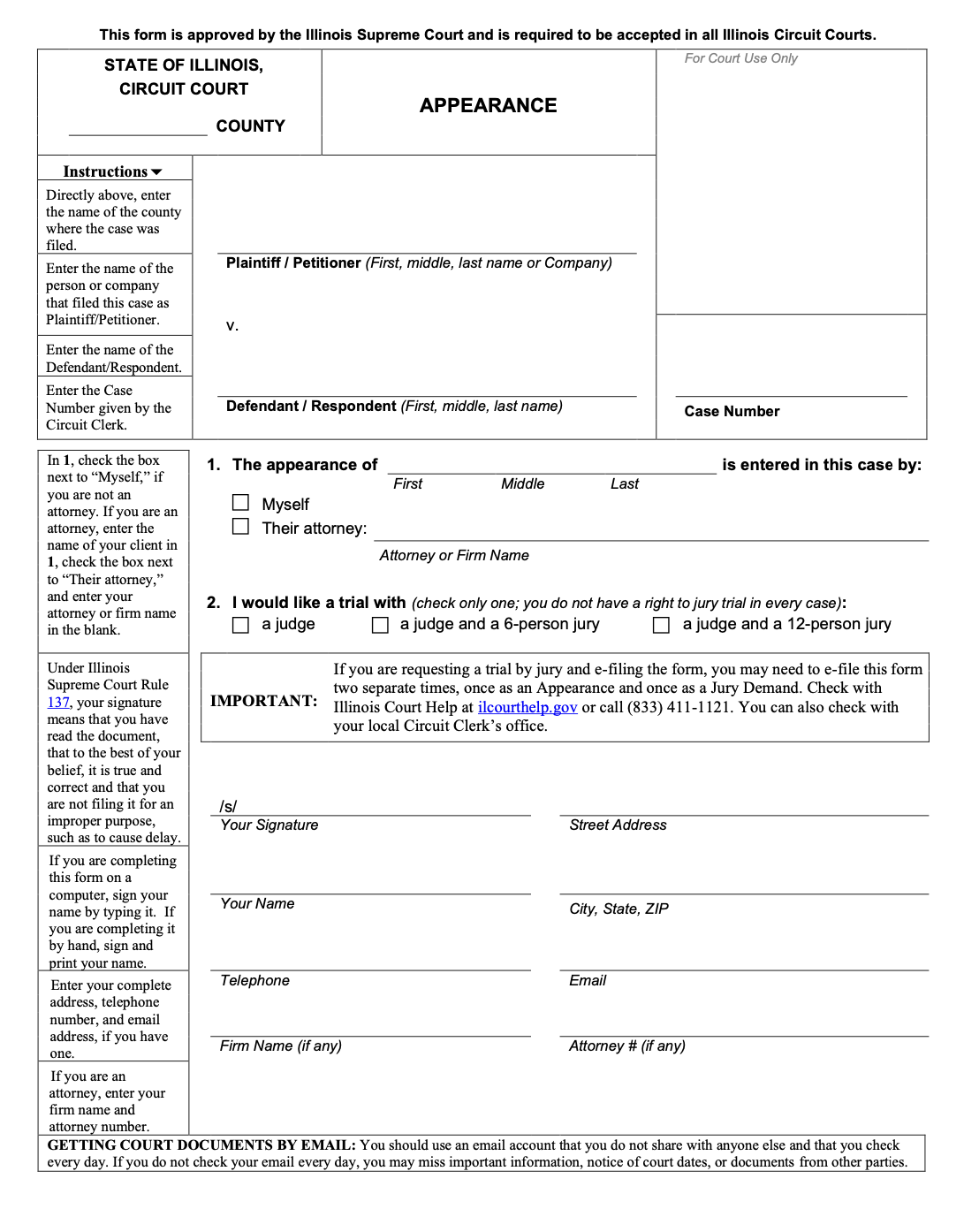
Though you can respond to a debt lawsuit on your own, if you want some extra help consider working with our partner, SoloSuit. They can help you draft and send a lawsuit response and negotiate a debt settlement. They even have a 100% money-back guarantee.
SoloSuit is an affiliate partner, which means Upsolve may earn a small commission if you choose to use their paid service. This helps keep our services free.
Step 1: Fill Out Personal Information and Select What Trial You Prefer
The first page of the appearance form is where you will fill out your personal information and select the type of trial you prefer. The options are:
Trial with a judge
Trial with a judge and a six-person jury
Trial with a judge and a 12-person jury
Here is what that section of the appearance form looks like:
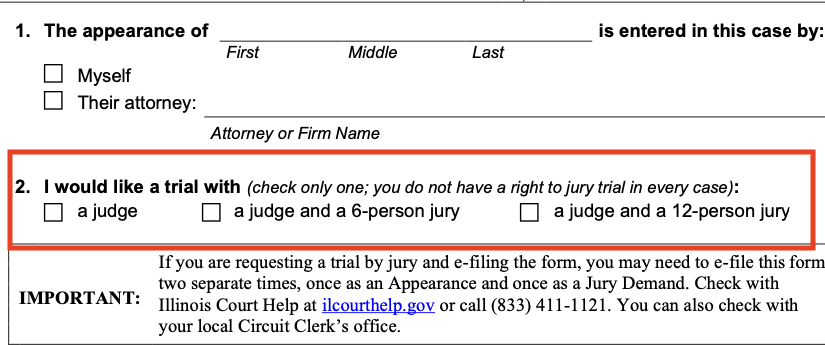
As stated in the appearance form, you do not have a right to a jury trial in every case. Selecting the trial option on the form shows the court your preference, but it’s not a guarantee you will get the type of trial you requested.
If you select one of the trial-by-jury options, check with the court that served you to see if you need to file the appearance form twice, the second submission counts as a Jury Demand.
Step 2: Complete Proof of Delivery
The next section is the proof of delivery section. This is where you fill out the plaintiff’s information and select how you will deliver a copy of the filed appearance to the plaintiff (or their lawyer if they have one).
This is what the proof of delivery section looks like:
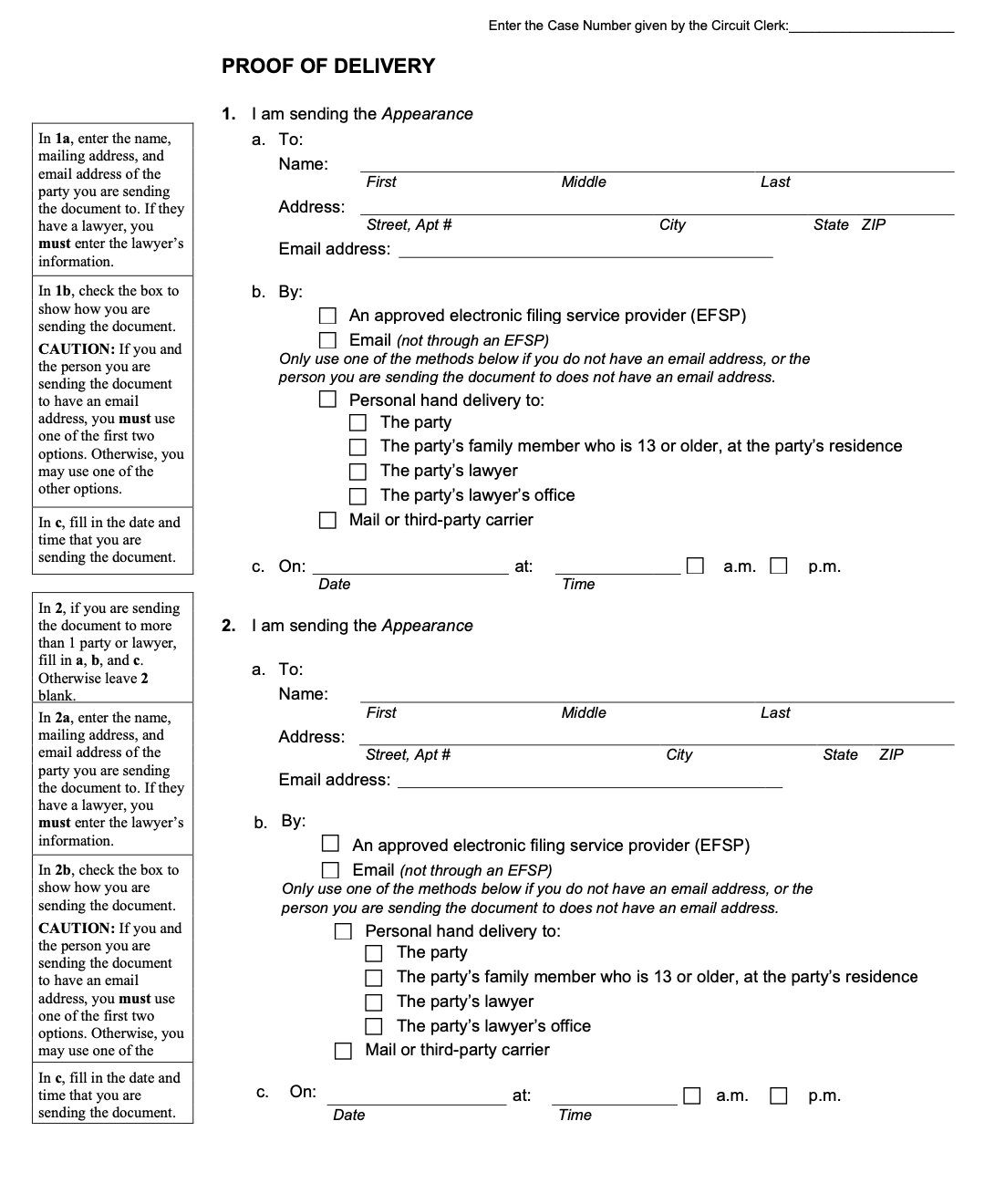
You will fill out the plaintiff’s name, address, and email and select the method of delivery.
You will then sign the very last page of the appearance form that certifies (agrees) that the information you provided in the proof of delivery section is accurate.
This is what that section looks like:
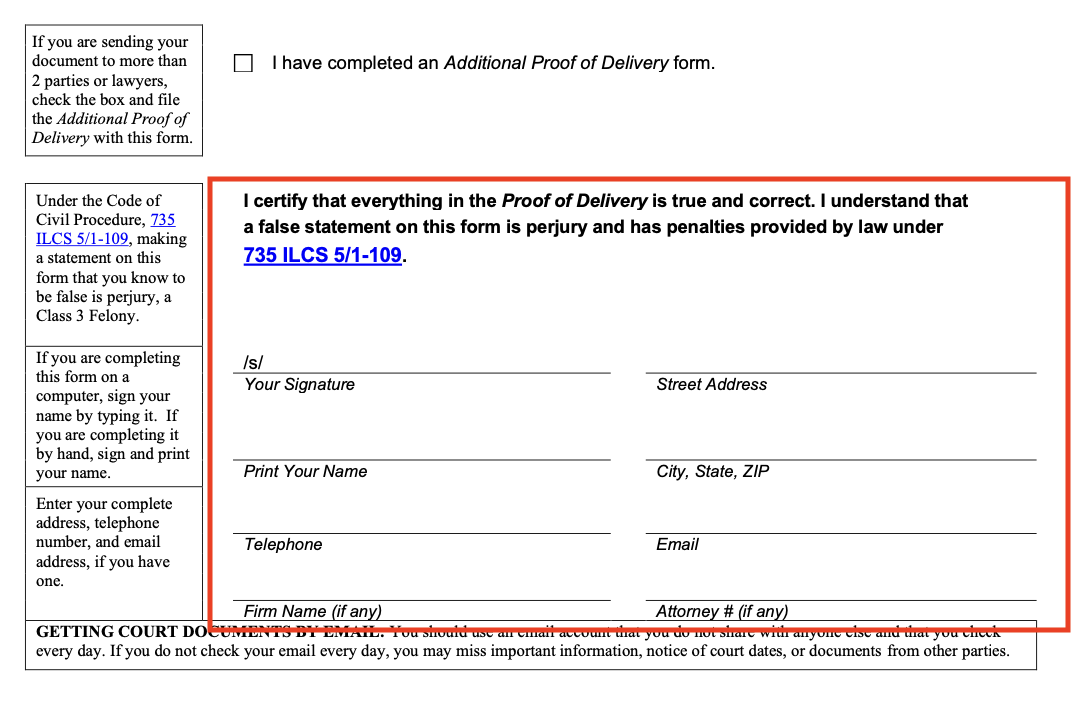
Step 3: File Your Forms With the Court Within 30 Days
Unless your court papers say otherwise, you are generally required to file your appearance within 30 days of receiving your summons and complaint.
Again, in Illinois you are required to e-file your paperwork unless you have a valid exemption.
The Illinois Courts has an e-filing system called eFile Illinois that can help you prepare, file, and send electronic copies to the other parties involved in the lawsuit.
Illinois Legal Aid Online also has an Appearance eFile Easy Form program that can help you create and e-file your appearance form.
Filing Procedures Vary by County in Illinois
Your summons should include instructions for when and where to file your appearance form and other information about the court. Procedures vary among small claims courts. Here are some examples:
In Lake County, the summons will contain a return date. You must file an appearance before the return date. If you don’t, you must show up in court on the return date or the plaintiff can get a default judgment against you. If you file an appearance before the return date, you don’t have to go to court on that day. The clerk will set a trial date for your case (usually 14 days later).
In Montgomery County, the summons will contain an appearance date. You must either file an appearance or other motion no later than five days before the appearance date, or else show up to court on the appearance date.
In Madison County, the summons will contain an appearance date. You must appear — and file your answer, if you’re filing one — on or before the appearance date, or else appear in person on that date. In all cases, on or before the appearance date you must either pay an answer fee or file an application to waive the fee.
Step 4: Serve a Copy of the Appearance on the Plaintiff
To serve the appearance on the plaintiff, you simply need to deliver a stamped copy of the appearance form to the plaintiff or their lawyer if they have one.
Since Illinois requires e-filing (unless you have an exemption), you will most likely deliver the copy through the e-filing system.
If you are exempt from e-filing, you can send the appearance via mail or in person. This is a last-resort option, and it’s only applicable if the person you’re sending the appearance copy to doesn’t have an email address.
You need to send the copy to the plaintiff by 5 p.m. on the same day you file with the court.
How Do You Fill Out and Complete an Answer Form?
In small claims court in Illinois, you don’t have to file an answer, which is formal paperwork in response to the lawsuit, if you’re being sued for less than $10,000. Though it’s not required, filing an answer can still be a good idea because it gives you the chance to think through and explain your responses.
Note: if you choose to file an answer, you still need to file an appearance as well. Also, some courts may charge a fee to file an answer if it’s not required, so it is best to check your court’s requirements.
The Illinois Courts website has great resources for learning how to prepare and file your answer. You can download the answer form right from the website.
This is what the first page of the Illinois answer form looks like:
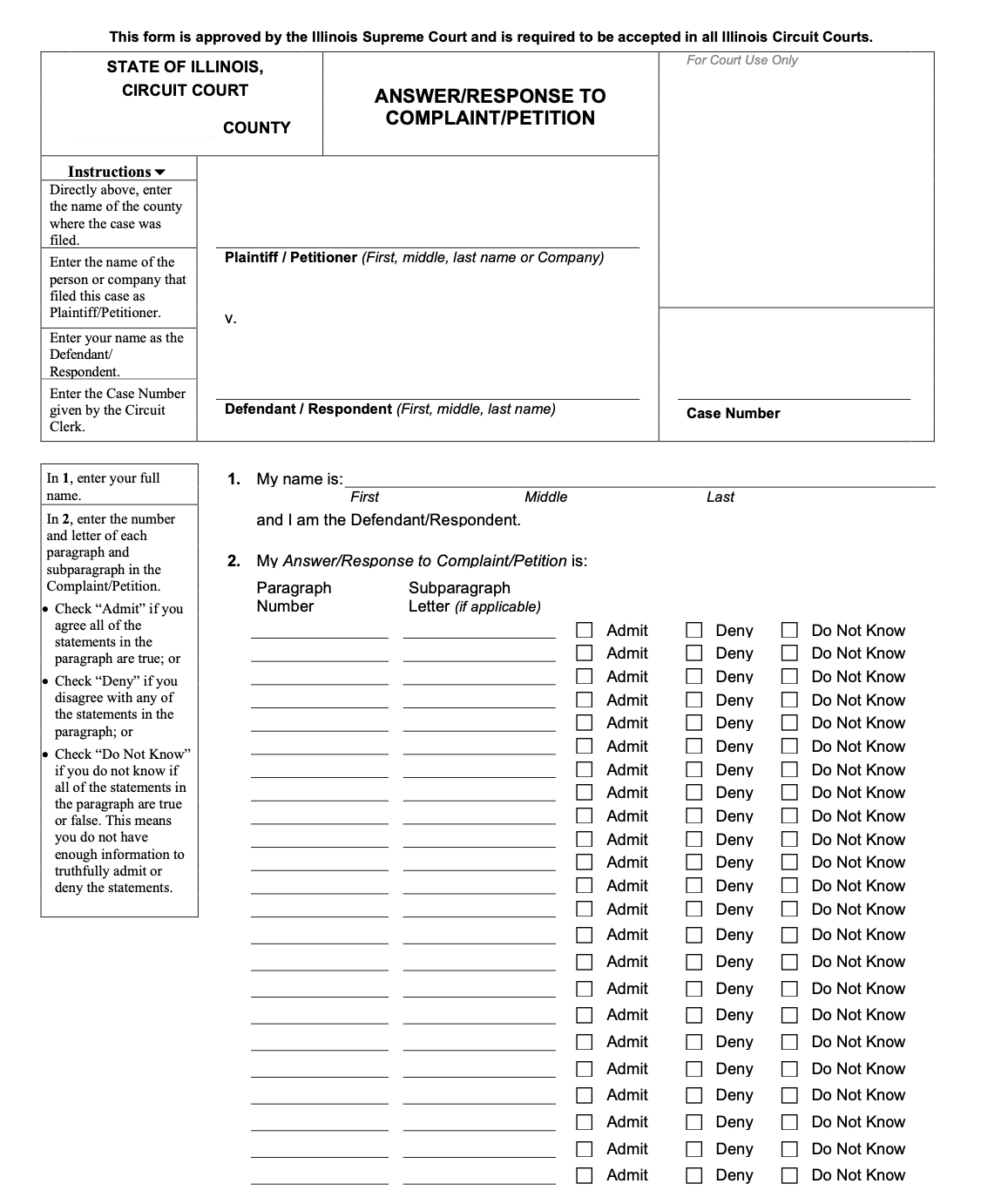
Respond to Each Claim Outlined on the Complaint
On this first page, you can see the Answer/Response section. This is where you follow along with the complaint and either admit, deny, or state you “do not know” if the claim is true or false.
To admit to a claim means you agree with it, to deny a claim means you disagree with it, and to claim you “do not know” means you lack the knowledge to determine if the claim is true or false.
E-File Your Answer Form by the Date Determined on Your Summons
In Illinois, you are required to e-file your answer form unless you meet the requirements for an exemption. Exemptions include:
Being an inmate in a prison or jail (who doesn’t have a lawyer)
Having a disability that prevents you from being able to e-file
Not having computer or internet access at home or not having the ability to travel to gain computer and internet access
If any of these reflects your situation, you will need to file a Certification for Exemption from E-Filing. Then, you can file your answer form (along with the certificate for exemption) with the court in person or by mail.
How To Prepare for Court Appearances
Showing up to court is the best thing you can do for yourself. If you do not show up, you are likely guaranteeing a win for the plaintiff (debt collector).
Your paperwork should tell you your court date, but you can always check with the court clerk from where you were served.
Here are some tips from Illinois Legal Aid Online about how to prepare for your court appearance:
Treat it like a job interview — dress appropriately, show up early, etc.
Bring copies of all documents (copies of answer forms/appearance forms/defenses etc.)
Bring a photo ID
Know the details of your cases — plaintiff’s name, contact information, etc.
What Happens if You Don’t Respond to the Lawsuit?
The most important thing you can do in a lawsuit is acknowledge it and take action. If you ignore a lawsuit, it won’t just go away. Instead, you’re likely to lose the case. This means the judge assigned to your case could issue a default judgment against you.
A default judgment is a court order that allows the person or company suing you to request a court order for wage garnishment, a bank account levy, or a property lien.
Debt collectors count on you not showing up to court or responding to the lawsuit. If you take action and respond to the lawsuit, you give yourself a fighting chance to win the debt collection lawsuit.
What Do I Do if the Court Already Issued a Default Judgment Against Me?
If a default judgment has already been ordered against you, you can file a motion to vacate the judgment. To vacate means to cancel the judgment ordered.
You can file this motion by submitting an official request with the court you were served from. This process can be difficult to navigate, so seek legal help as needed. Illinois Legal Aid Online may be able to help through their online services.
Need Legal Help?
Illinois Legal Aid Online has online self-help resources, forms, and referrals to local legal aid providers across the state.
Illinois Attorney General’s Legal Assistance Referrals has a comprehensive list of links and contact information for law schools, bar associations, and nonprofit organizations, organized by location.
Illinois State Bar Association has links to verified statewide and location-based legal aid organizations.
